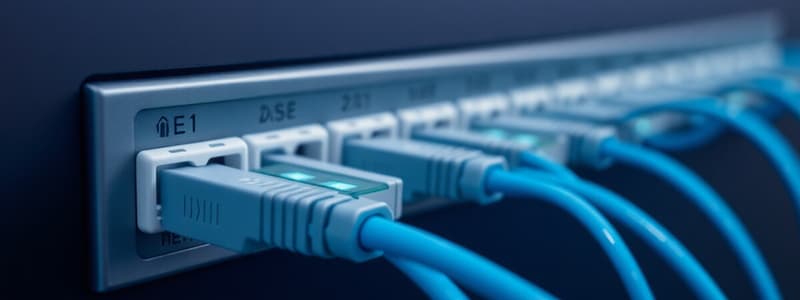Podcast
Questions and Answers
What is a primary reason WISP is advantageous in certain areas?
What is a primary reason WISP is advantageous in certain areas?
- It requires no equipment for setup.
- It is available in areas lacking traditional wired infrastructure. (correct)
- It uses existing phone lines for connectivity.
- It provides higher speeds than fiber connections.
What is the typical speed range that users can expect from WISP?
What is the typical speed range that users can expect from WISP?
- 100 to 500 Mbps
- 10 to 50 Mbps
- 25 to 100 Mbps (correct)
- 5 to 15 Mbps
What infrastructure does WISP utilize to extend its network coverage?
What infrastructure does WISP utilize to extend its network coverage?
- Satellite relays positioned in space
- Wired connections to nearby residences
- A fiber backbone connected to antennas (correct)
- A series of ground-based fiber cables
Which of the following is NOT an advantage of WISP compared to wired internet options?
Which of the following is NOT an advantage of WISP compared to wired internet options?
In order to connect to WISP, what equipment do users typically need?
In order to connect to WISP, what equipment do users typically need?
What is the primary difference between upload speed and download speed?
What is the primary difference between upload speed and download speed?
What type of cable does cable internet primarily use for its connections?
What type of cable does cable internet primarily use for its connections?
Why might individual speeds be slower than the plans customers signed up for during peak hours with cable internet?
Why might individual speeds be slower than the plans customers signed up for during peak hours with cable internet?
How are internet speeds measured?
How are internet speeds measured?
Which internet connection type typically offers a higher download rate compared to upload rate?
Which internet connection type typically offers a higher download rate compared to upload rate?
What is the mathematical relationship to determine download speed from internet speed?
What is the mathematical relationship to determine download speed from internet speed?
Which of the following statements about cable internet is NOT true?
Which of the following statements about cable internet is NOT true?
In general, which type of internet service is least likely to have symmetrical upload and download speeds?
In general, which type of internet service is least likely to have symmetrical upload and download speeds?
What technique does DSL use to allow for simultaneous signals on the same phone line?
What technique does DSL use to allow for simultaneous signals on the same phone line?
What is the maximum typical speed for DSL internet?
What is the maximum typical speed for DSL internet?
What type of DSL connection offers fast download speeds but slow upload speeds?
What type of DSL connection offers fast download speeds but slow upload speeds?
What is one of the main benefits of fiber internet?
What is one of the main benefits of fiber internet?
What is a significant drawback of satellite internet?
What is a significant drawback of satellite internet?
Which internet connection method can be affected by environmental interference?
Which internet connection method can be affected by environmental interference?
What must be done to ensure a phone can work simultaneously with DSL on the same line?
What must be done to ensure a phone can work simultaneously with DSL on the same line?
What is the main means by which fiber internet connects to devices inside a building?
What is the main means by which fiber internet connects to devices inside a building?
Why might satellite internet be a poor choice for time-sensitive applications?
Why might satellite internet be a poor choice for time-sensitive applications?
Which service typically has a monthly data cap that may limit heavy users?
Which service typically has a monthly data cap that may limit heavy users?
Which of the following is not a benefit of ADSL compared to SDSL?
Which of the following is not a benefit of ADSL compared to SDSL?
What is a primary challenge in implementing fiber internet services?
What is a primary challenge in implementing fiber internet services?
What is one of the notable characteristics of cellular internet?
What is one of the notable characteristics of cellular internet?
How does DSL manage to provide internet over standard telephone lines?
How does DSL manage to provide internet over standard telephone lines?
What is a challenge with using satellite internet for everyday tasks?
What is a challenge with using satellite internet for everyday tasks?
Flashcards are hidden until you start studying
Study Notes
Internet Connection Options
- Most common internet connection options for homes and small businesses include cable, DSL, fiber, satellite, cellular and Wireless Internet Service Providers (WISPs).
- Download speed is how fast data is retrieved, upload speed is how fast data is sent.
- Download speed in megabytes per second (MB/s) is calculated by dividing the internet speed in megabits per second (Mbps) by 8.
Cable Internet
- Uses existing coaxial cable infrastructure.
- Speeds vary greatly depending on the area.
- Offers high download speeds but slower upload speeds.
- Bandwidth is shared by users in the area, leading to potential slowdown during peak hours.
Digital Subscriber Line (DSL)
- Uses existing phone lines to provide high-speed internet.
- Uses multiplexing technique to create two channels: one for phone communications and one for DSL communication.
- Requires special DSL filters to block DSL signal from phone line.
- Asymmetric DSL (ADSL) provides fast download speeds but slow upload speeds.
- Symmetric DSL (SDSL) provides equal upload and download speeds but is more expensive.
- Speeds typically max out at 100 Mbps and are affected by distance from the main hub.
- DSL is not shared with other users in the area.
Fiber Internet
- Uses fiber optic cables to transfer data using light.
- Offers symmetrical upload and download speeds.
- Results in lower latency and improved performance for media streaming, gaming and file downloads.
- Requires new infrastructure, not available in many areas.
Satellite Internet
- Connects to the internet via orbiting satellites.
- Requires a clear line of sight to the sky, making it ideal for remote locations.
- Provides reasonably fast download speeds but slow upload speeds.
- Experiences high latency due to the distance involved in data transmission.
- Not ideal for time-sensitive applications like gaming, voice data or video calls.
- Usually has a monthly data cap.
Cellular Internet
- Uses existing cellular infrastructure.
- Can be accessed via adapters like USB adapters or mobile hotspots.
- Offers good download speeds but slow upload speeds.
- Latency and environmental interference are potential issues.
- Provides mobility as it is accessible in areas with phone service.
Wireless Internet Service Provider (WISP)
- Provides wireless connectivity, often used in rural areas where wired internet is not readily available.
- Uses a wireless mesh network operating on open radio bands.
- Uses a fiber backbone in a central location to connect to a large antenna.
- Smaller antennas are installed to extend coverage.
- Users receive a satellite or antenna connected to their buildings.
- Speeds are typically lower than wired connections, ranging from 25 to 100 Mbps.
Summary
- This lesson covered various residential and small business internet connection options.
- Cable internet, DSL and Fiber internet are wired connection choices.
- Satellite internet, cellular internet and WISP cater to areas without wired connections.
- Wired internet offers faster speeds while wireless options have latency issues and require specific equipment.
Studying That Suits You
Use AI to generate personalized quizzes and flashcards to suit your learning preferences.




